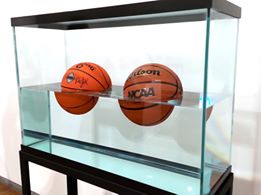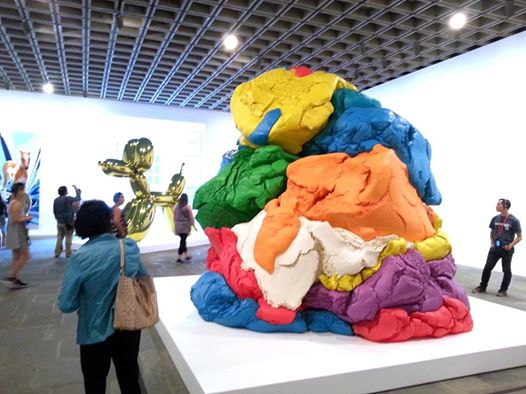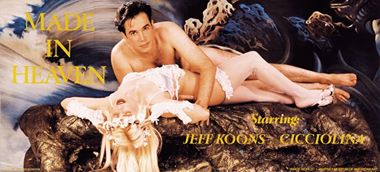Frankie Goes to Hollywood(FGTH), is an 80’s British band that had a hit with their single “Relax”. They released a greatest hits album, “Bang! The Greatest Hits Album of Frankie Goes to Hollywood”. It has only one hit on it. It is called “Relax”. Which brings to mind Jeff Koons. He is the Frankie Goes to Hollywood of artists. A one-hit-wonder or at best a three-hit-wonder. He also has a greatest hits album. It’s now playing at the Whitney Museum of Art.
Koons is the ultimate Post Modernist. With sardonic references to art historical styles, appropriation and irony he subverts all that is dear to Modernism. One Ball Total Equilibrium Tank (Spalding DR. J 241 Series) has a basketball floating in a tank of water that is mounted on a steel table. The purity of modernism (Donald Judd) is undermined by pop imagery (Warhol). It makes an elegant simple statement while at the same time celebrating the banal. The ball isn't soldered to another piece of steel. Salt and distilled water hold it in suspension. No wires are used. It floats magically and motionlessly. You can't help but think of the late Frank Caro’s obsession with weightlessness as a sculptural end game. But unlike Caro this work isn't constructivist. Koons uses water as his medium to hold a readymade in place. Like an aquarium this piece has to be routinely cleaned and the water replaced. Damien Hirst couldn't have put a shark in a tank without first being inspired by Koons.

WIth Balloon Dog (1994-2000), Koons fixates on the transformative powers of material by the manipulation of surface. Warhol’s Brillo (1964) boxes are an obvious inspiration. But Koons doesn’t subvert Modernism by reconstructing advertising iconography. Instead he bases his work on a readymade interpretation of reality–the balloon abstraction of a dog. The use of scale creates a surprising disruption. The piece is massive and monumental while being as fragile as a Christmas tree ornament. It appears to be cast but it is actually over 30 pieces of metal that are attached.The yellow color, surface and subject make it feel like it could float away.

Play-Doh (1994-2014) took over 20 years to build. Koons felt he couldn't finish it until technology was sophisticated enough to pull it off. Play-Doh is enormous and just sits there all mashed up into one large piece. So much for composition! Once again color, surface and texture are transformative. This is a sculpture that you feel as well as look at. The work appears to be malleable and you just want to tear off a piece and make something with it. Using constructivism to create a sculpture whose subject is clay is about as ironic as it gets. I just hope Play-Doh doesn’t dry out with time.
The rest of the show is cannon fodder. You get the feeling Koons must maintain a large output to pay for La Cicciolina’s alimony. His paintings are slick knock-offs of Rosenquist. There is so much camp here it feels like you are in Yellowstone National Park.
His “Made in Heaven” series really nails it. Jeffie Goes to Hollywood.

Written by Tom McManus
